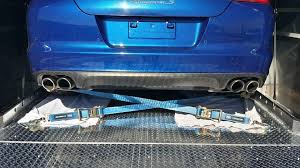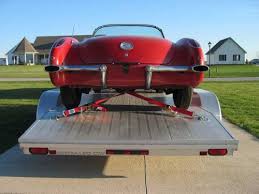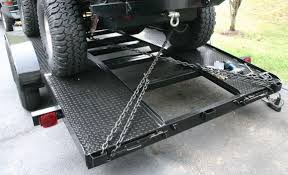Auto Vehicle Warnings & Tow Strap Warnings for Drivers

STOP! Read these warnings and instructions completely before use. Use of this product shall be by a COMPETENT PERSON and demonstrates a clear understanding of these warnings and instructions and the hazards and risks involved.
Set vehicle emergency brake; engine must be off and transmission must be in Park (Reverse or 1st gear if manual trans). Steering must be immobilized by lock, bar or web strap.
Follow the vehicle manufacturer’s securement instructions for vehicle trailer hauling, rail or ocean transport. Know the vehicle weight prior to securing (www.nada.com).
Do not mix webbing strap tie downs with chain tie downs on the same vehicle being secured. Tie downs are to be as short as possible.
Tie down tension should be evenly applied. If not feasible, upgrade or add tie downs.
Secure vehicle with a minimum of four (4) three point webbing tie down straps, one at each tire. With some vehicles, webbing axle tie down straps may be used, minimum two (2) per axle, securing all 4 corners of the vehicle.
Three point tie down straps must be centered on the tire and run parallel with tire treads. Tie downs shall not pull inward or outward.
Three point tie down straps may not be twisted and must lay flat to the decks and over tires. Keep webbing clear of metal edges and foreign protrusions. Web Protective Sleeves may be Necessary for Proper Operation.
Strap fittings shall fit and constrain to stamped eyelets or other structurally sound intervals in the deck or on the trailer. Strap fittings and ratchet shall not come in contact with the vehicle being secured. All tie downs are only as strong as their weakest component, including the points of attachment. Re-tension tie downs as required by necessity or by law.
One point, two point or lasso tie downs are for short distance towing and should not be used for vehicle trailer hauling, rail or ocean transport. Do not attach tie downs to vehicle suspension components as vertical movement during transport will cause straps to stretch, loosening tie downs. Webbing strap tie downs used on tires or axles are not affected by vehicle suspension movement.
Inverted basket type straps may also be used but must run parallel with tire treads and shall not pull inward or outward.
If web-only wheel lashing straps are approved: All 4 wheels must be lashed; Lashing straps should be run through the wheel spokes (not the tire) near the bottom at an angle to the deck of 15 to 45 degrees. Lashing straps shall avoid the tire valve, stem, wheel balance weights and all other vehicle or deck components.
Tie down straps deteriorate over time. A competent person shall inspect this product based on use and age, making a record of the results.
COMPETENT PERSON: Diagonal tie downs should only be applied when the horizontal angle from the driving direction to the tie down is fixed between 20 degrees and 45 degrees - AND - when the vertical angle from the deck to the tie down is between 0 degrees and 30 degrees.
©All Text of this Vehicle Tie Down Label is Copyright 2016 by RatchetStrap.com. No reproduction, modification, distribution or republication without permission.
RatchetStrap.com AT16

